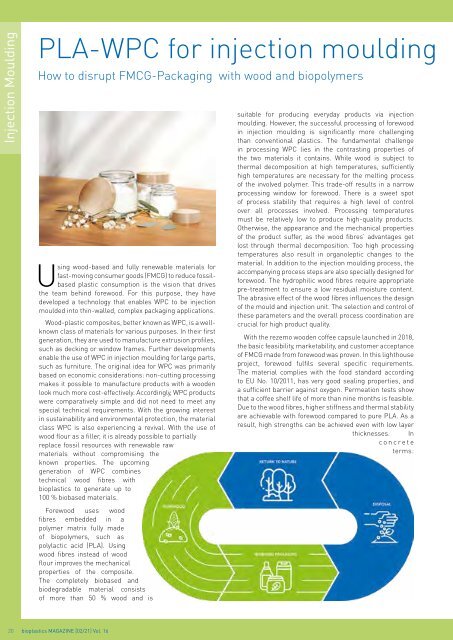issue 02/2021
Highlights: Injection Moulding Basics: Mass Balance
Highlights:
Injection Moulding
Basics: Mass Balance
Create successful ePaper yourself
Turn your PDF publications into a flip-book with our unique Google optimized e-Paper software.
Injection Moulding<br />
PLA-WPC for injection moulding<br />
How to disrupt FMCG-Packaging with wood and biopolymers<br />
Using wood-based and fully renewable materials for<br />
fast-moving consumer goods (FMCG) to reduce fossilbased<br />
plastic consumption is the vision that drives<br />
the team behind forewood. For this purpose, they have<br />
developed a technology that enables WPC to be injection<br />
moulded into thin-walled, complex packaging applications.<br />
Wood-plastic composites, better known as WPC, is a wellknown<br />
class of materials for various purposes. In their first<br />
generation, they are used to manufacture extrusion profiles,<br />
such as decking or window frames. Further developments<br />
enable the use of WPC in injection moulding for large parts,<br />
such as furniture. The original idea for WPC was primarily<br />
based on economic considerations: non-cutting processing<br />
makes it possible to manufacture products with a wooden<br />
look much more cost-effectively. Accordingly, WPC products<br />
were comparatively simple and did not need to meet any<br />
special technical requirements. With the growing interest<br />
in sustainability and environmental protection, the material<br />
class WPC is also experiencing a revival. With the use of<br />
wood flour as a filler, it is already possible to partially<br />
replace fossil resources with renewable raw<br />
materials without compromising the<br />
known properties. The upcoming<br />
generation of WPC combines<br />
technical wood fibres with<br />
bioplastics to generate up to<br />
100 % biobased materials.<br />
Forewood uses wood<br />
fibres embedded in a<br />
polymer matrix fully made<br />
of biopolymers, such as<br />
polylactic acid (PLA). Using<br />
wood fibres instead of wood<br />
flour improves the mechanical<br />
properties of the composite.<br />
The completely biobased and<br />
biodegradable material consists<br />
of more than 50 % wood and is<br />
suitable for producing everyday products via injection<br />
moulding. However, the successful processing of forewood<br />
in injection moulding is significantly more challenging<br />
than conventional plastics. The fundamental challenge<br />
in processing WPC lies in the contrasting properties of<br />
the two materials it contains. While wood is subject to<br />
thermal decomposition at high temperatures, sufficiently<br />
high temperatures are necessary for the melting process<br />
of the involved polymer. This trade-off results in a narrow<br />
processing window for forewood. There is a sweet spot<br />
of process stability that requires a high level of control<br />
over all processes involved. Processing temperatures<br />
must be relatively low to produce high-quality products.<br />
Otherwise, the appearance and the mechanical properties<br />
of the product suffer, as the wood fibres’ advantages get<br />
lost through thermal decomposition. Too high processing<br />
temperatures also result in organoleptic changes to the<br />
material. In addition to the injection moulding process, the<br />
accompanying process steps are also specially designed for<br />
forewood. The hydrophilic wood fibres require appropriate<br />
pre-treatment to ensure a low residual moisture content.<br />
The abrasive effect of the wood fibres influences the design<br />
of the mould and injection unit. The selection and control of<br />
these parameters and the overall process coordination are<br />
crucial for high product quality.<br />
With the rezemo wooden coffee capsule launched in 2018,<br />
the basic feasibility, marketability, and customer acceptance<br />
of FMCG made from forewood was proven. In this lighthouse<br />
project, forewood fulfils several specific requirements.<br />
The material complies with the food standard according<br />
to EU No. 10/2011, has very good sealing properties, and<br />
a sufficient barrier against oxygen. Permeation tests show<br />
that a coffee shelf life of more than nine months is feasible.<br />
Due to the wood fibres, higher stiffness and thermal stability<br />
are achievable with forewood compared to pure PLA. As a<br />
result, high strengths can be achieved even with low layer<br />
thicknesses. In<br />
concrete<br />
terms:<br />
20 bioplastics MAGAZINE [<strong>02</strong>/21] Vol. 16


















